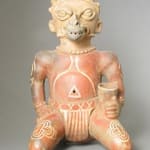Sculpture of a Seated Saurian Deity Holding a Cup, 300 BCE - 300 CE
Terracotta
18.75
PF.4040
Further images
-
(View a larger image of thumbnail 1
)

-
(View a larger image of thumbnail 2
)

-
(View a larger image of thumbnail 3
)

-
(View a larger image of thumbnail 4
)

-
(View a larger image of thumbnail 5
)

-
(View a larger image of thumbnail 6
)

-
(View a larger image of thumbnail 7
)

-
(View a larger image of thumbnail 8
)

From the ancient depths of the culturally rich country of Costa Rica, we have before us a fine example of the artistry that flourished during the latter developments of Period...
From the ancient depths of the culturally rich country of Costa Rica, we have before us a fine example of the artistry that flourished during the latter developments of Period IV. Terracotta is not a simple medium to handle. To achieve the desired effects of this powerful, robust male figure, the artist has acquired a very special skill in manipulating the medium that was most available to him. Through trial and error and numerous years of practice, this artist has created a spectacular work of art. The composition as a whole flows together from head to toe. Many clues have been left for us to decipher, as well. Has his body paint been carefully applied for ritual rites for a particular event? Or did he wear body paint every day? Notice the triangle that surrounds his navel and the different symbols adorning his upper legs and upper arms. These are truly magnificent symbols that we have yet to decipher. Clasped in one of his arms is a drinking vessel. This vessel may symbolize that a magical potion was taken in order for the shaman to transform into his animal form or alter ego, the crocodile. Through transformation, the shaman was able to communicate with the underworld and the upper world, foretell the future or gain warrior-like qualities for the society to ward off any intruders. The elaborate crocodile mask must have created a dramatic spectacle for the participating audience. Shamans were both admired and feared and this sculpture may trigger those emotions or any number of emotions and thoughts. As our imagination runs wild, we may tremble with a new desire to obtain part of this magical ancient history and culture. A need may surface to acquire this ancient artifact without an understanding as to why. Is it for the rarity, the mystery or simply the necessity of collecting fine art?







